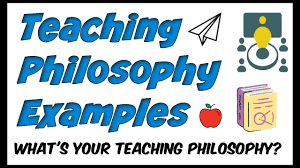Exploring Teaching Philosophy Examples
Teaching philosophy is the foundation upon which educators build their instructional practices and approaches. It reflects their beliefs, values, and principles regarding teaching and learning. By examining various teaching philosophy examples, we can gain insight into the diverse perspectives and strategies that educators employ to engage and inspire their students.
Example 1: The Socratic Method
One classic teaching philosophy example is the Socratic Method, named after the ancient Greek philosopher Socrates. This approach emphasizes critical thinking, questioning, and dialogue between teachers and students. The Socratic Method encourages students to actively engage in discussions, challenge assumptions, and explore complex ideas through thoughtful inquiry.
Example 2: Constructivism
Another prevalent teaching philosophy is constructivism, which posits that learners construct knowledge through their experiences and interactions with the world. Educators who adhere to constructivist principles believe in creating hands-on learning opportunities, encouraging collaboration among students, and fostering a student-centered approach to education.
Example 3: Social-Emotional Learning (SEL)
In recent years, there has been a growing emphasis on social-emotional learning (SEL) as a fundamental aspect of education. Educators who prioritize SEL in their teaching philosophy focus on developing students’ emotional intelligence, interpersonal skills, empathy, and resilience. They create a supportive classroom environment where students feel valued, understood, and empowered to succeed academically and personally.
Example 4: Culturally Responsive Teaching
Culturally responsive teaching is another essential teaching philosophy that recognizes the diversity of students’ backgrounds, experiences, and identities. Educators who practice culturally responsive teaching strive to incorporate diverse perspectives, histories, and cultural traditions into their curriculum. They aim to create an inclusive learning environment where all students feel represented, respected, and empowered to learn.
Conclusion
Teaching philosophy examples demonstrate the wide range of approaches that educators can adopt to engage students effectively. By reflecting on different teaching philosophies and considering how they align with our own beliefs and values as educators, we can enhance our instructional practices and create meaningful learning experiences for our students.
Six Effective Strategies for Bringing Philosophy to Life in the Classroom
- Use real-life examples to illustrate philosophical concepts.
- Encourage critical thinking and open discussion in the classroom.
- Relate philosophical ideas to current events or popular culture to engage students.
- Provide opportunities for students to apply philosophical theories to their own experiences.
- Incorporate a variety of teaching methods such as group discussions, debates, and multimedia presentations.
- Offer guidance and support for students exploring complex philosophical topics.
Use real-life examples to illustrate philosophical concepts.
Incorporating real-life examples to illustrate philosophical concepts is a powerful teaching strategy that can enhance students’ understanding and engagement. By connecting abstract ideas to concrete, relatable situations, educators can make complex philosophical concepts more accessible and meaningful to learners. Real-life examples not only provide context and relevance but also encourage critical thinking and application of theoretical knowledge in practical scenarios. This approach helps students see the relevance of philosophy in everyday life and fosters a deeper appreciation for the subject matter.
Encourage critical thinking and open discussion in the classroom.
Encouraging critical thinking and open discussion in the classroom is a fundamental aspect of effective teaching philosophy examples. By fostering an environment where students feel comfortable questioning ideas, challenging assumptions, and engaging in meaningful dialogue, educators can empower learners to develop their analytical skills, broaden their perspectives, and deepen their understanding of complex concepts. Through critical thinking and open discussion, students not only enhance their cognitive abilities but also cultivate essential communication skills, empathy, and respect for diverse viewpoints, preparing them to become informed and engaged members of society.
Relate philosophical ideas to current events or popular culture to engage students.
To enhance student engagement in the classroom, educators can effectively relate philosophical ideas to current events or popular culture. By connecting abstract concepts to real-world examples that students are familiar with, teachers can make philosophy more relevant and accessible. This approach not only helps students understand complex theories better but also encourages critical thinking and active participation in discussions. By bridging the gap between philosophy and everyday life, educators can create a dynamic learning environment that sparks curiosity and stimulates intellectual growth among students.
Provide opportunities for students to apply philosophical theories to their own experiences.
To enhance students’ understanding and engagement with philosophical theories, educators can provide opportunities for them to apply these concepts to their own experiences. By encouraging students to reflect on how philosophical ideas relate to their personal lives, beliefs, and values, teachers can foster critical thinking skills and deepen students’ connection to the material. This approach not only makes abstract theories more relatable and relevant but also empowers students to see the practical implications of philosophy in their everyday lives.
Incorporate a variety of teaching methods such as group discussions, debates, and multimedia presentations.
To enhance the effectiveness of teaching philosophy examples, educators should incorporate a variety of teaching methods such as group discussions, debates, and multimedia presentations. By utilizing diverse instructional strategies, teachers can cater to different learning styles, promote active student engagement, and create dynamic learning experiences. Group discussions encourage collaborative learning and critical thinking skills, debates foster argumentation and persuasion abilities, while multimedia presentations appeal to visual and auditory learners. Integrating these varied teaching methods not only enhances the depth of understanding but also cultivates a stimulating and interactive classroom environment that motivates students to actively participate in their own learning journey.
Offer guidance and support for students exploring complex philosophical topics.
When incorporating teaching philosophy examples into the curriculum, it is crucial for educators to offer guidance and support for students as they navigate complex philosophical topics. By providing clear explanations, facilitating discussions, and offering additional resources, teachers can help students develop a deeper understanding of challenging concepts and engage meaningfully with philosophical ideas. Creating a supportive learning environment where students feel encouraged to ask questions, express their thoughts, and explore different perspectives is essential for fostering critical thinking skills and intellectual growth in the study of philosophy.

